Procyon Vitals
| Official name | Procyon |
| Other designations | Alpha Canis Minoris, HR 2943, HD 61421 |
| Nicknames | - |
| Apparent magnitude | 0.37 |
| Distance | 11.46 light-years |
| Type | Main sequence, F5IV-V |
| Color | Yellow-white |
| Mass | 1.5 M☉ |
| Radius | 2.0 R☉ |
| Constellation | Canis Minor |
| Right ascension | 07h 39m 18s |
| Declination | 05° 13' 30" |
| Multiple system? | Yes |
| Variable star? | No |
| Exoplanets status | None known |
| Probable fate | White dwarf |
Physical Characteristics
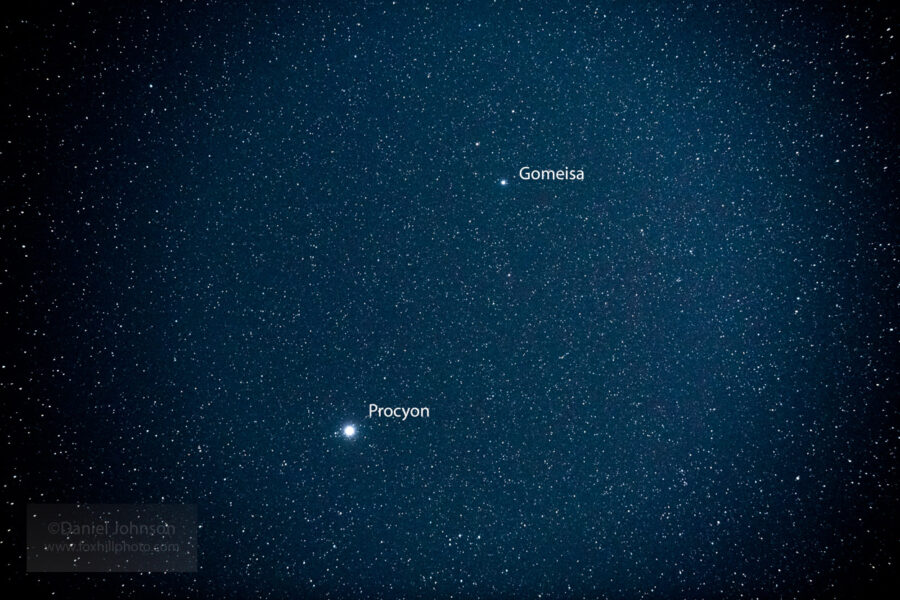
Daniel Johnson
If you’re a fan of classic cartoons, you might be familiar with a series of Warner Brothers short films that feature Chester, a little terrier, who is the devoted fan of Spike, a big bulldog. By the end of the show, Chester has proven his worth and the roles are reversed, so that the little dog is now the top dog.
Maybe tonight is the night for you to set aside the traditional big dog so that you can take a closer look at the little guy. You’re probably aware that Sirius (the “dog star”) represents the head of Canis Major — Orion’s hunting dog. But what you might not know is that Orion owns a second dog that’s smaller, fainter, and certainly not as well known. This constellation is Canis Minor, the Lesser Dog: a tiny group of stars with only two principal members, one of them the brilliant Procyon.
Even though Canis Minoris small, Procyon itself is a fine star, well worth more than a casual glance. Procyon has a spectral class of F5, a main-sequence star that is perhaps concluding that phase of its life and reaching the subgiant stage. Procyon’s core may be shifting to fusing only helium rather than hydrogen, a transition that will ultimately move the star to the red giant phase.
Procyon is currently not a large star, as it’s only about twice the Sun’s radius, but it’s a bright one that emits light levels about seven times higher — another indication that it may be slowly nearing the subgiant phase. Procyon usually appears essentially white, with perhaps a tinge of yellow.
Proycon is close to us at only 11.46 light-years away, and its physical proximity coupled with its natural brightness combine to make it the eighth-brightest star when viewed from Earth. If you could swap locations and look back at the Sun from Procyon, our star would appear quite a bit dimmer than Procyon, since the Sun is cooler and doesn’t emit as much light.
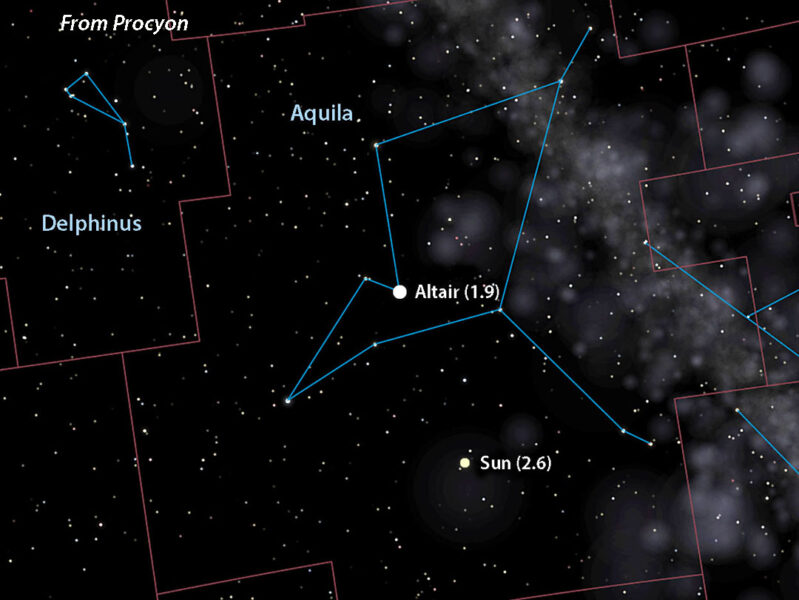
Celestia, with additions by Bob King
Sirius is famously joined by its white dwarf companion Sirius B; likewise, Procyon is also joined by a tiny white dwarf star, dubbed Procyon B. The extremely dense object has three-quarters of the Sun’s mass, but it’s only a little larger than Earth!
Origin / Mythology
As noted earlier, Canis Minor in the Greek tradition is one of Orion’s two hunting dogs. The hunter and his dogs are joined in the sky by the constellation Lepus, the Hare, who is apparently leading them in the chase.
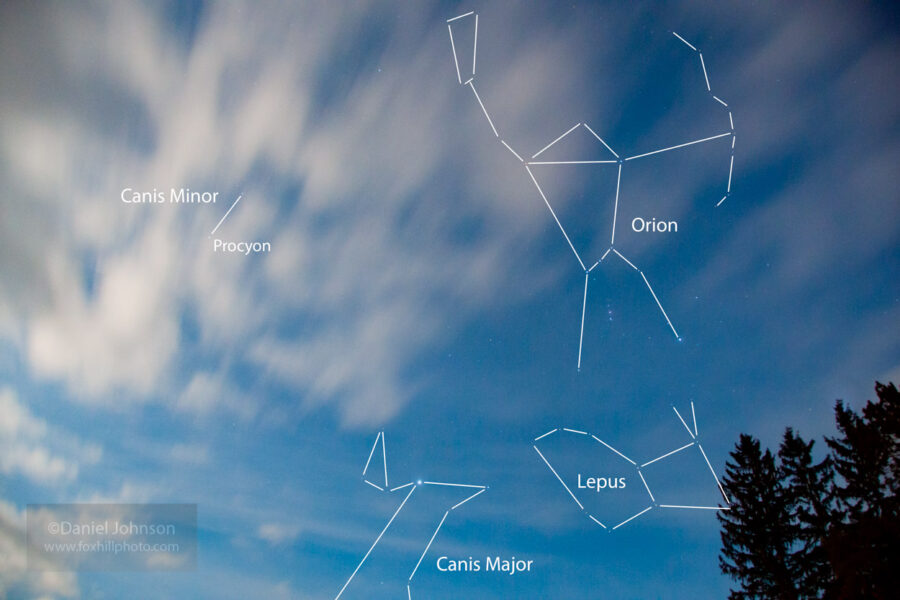
Daniel Johnson
The name Procyon is Greek and means “before the dog,” referring to the fact that Procyon used to rise much earlier than Sirius in ancient Greece. But because of Earth’s precession, this effect has become far less obvious as the centuries have passed. Procyon and Sirius now rise basically in tandem from Greece, with Procyon only slightly higher.
Canis Minor is one of the smallest constellations you’ll find. Except for a handful of dim stars that fall within its official boundaries, the constellation is made up of just Procyon and a nearby star called Gomeisa. No fun shapes, no connecting the dots, just two stars that look nothing like a dog and require plenty of imagination!
Procyon also had canine associations in ancient Egypt, where the star was connected to the mythological figure of Anubis. Ancient Mesopotamians associated Procyon with dogs, too. But other cultures saw things differently. For Polynesians living in what is now Tahiti, Procyon was a pillar that supported the sky, while the Ojibwe of North America actually included Procyon in their version of Orion, what they call the Wintermaker.
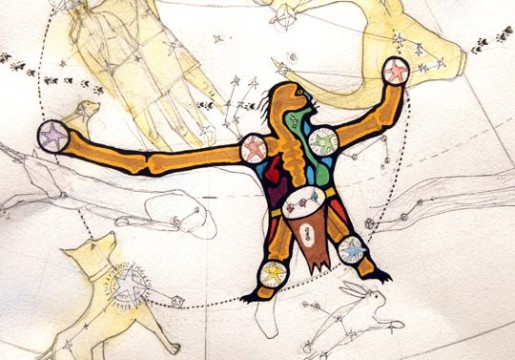
Annette Lee
How to See Procyon
Late winter and early spring evenings are excellent times to check out Procyon, as the star climbs well up above the horizon. As part of the so-called Winter Triangle, Procyon appears to lie about an equal distance from Sirius and Betelgeuse, making identification a snap. Procyon is also a member of the Winter Hexagon.
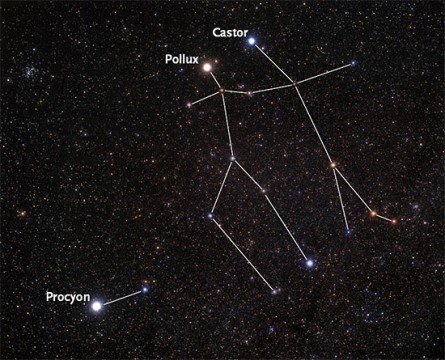
Akira Fujii
In the early winter, try to catch Procyon as it rises, and see if Procyon indeed outdoes Sirius and comes up “before the dog.” Northern areas of the U.S. will see Procyon rise slightly ahead of Sirius, while observers in the southern U.S. will actually see Sirius come up first by a tiny margin. Either way, this simple observation is a fun way to witness firsthand the effects of precession — something that occurs so slowly that we normally don’t notice it at all.
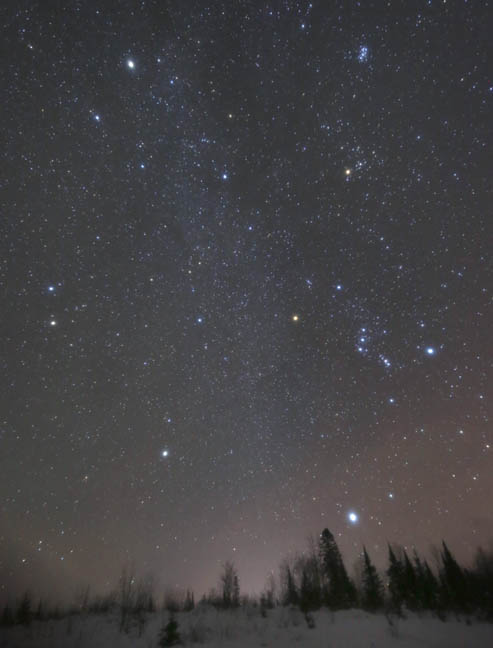
Bob King
Finding Procyon is no problem, but trying to see Procyon B (the white dwarf companion) is a major challenge. To have any hopes at all of splitting the two requires a massive telescope, a calm atmosphere, and abundant patience. Still, Procyon B will be reaching maximum separation from its parent star during the next few years, so if there was ever a time to try splitting the two, this is it.
The Lesser Dog may be smaller and dimmer than Sirius, but he has plenty to offer, so why not give this “Chester” a chance in your stargazing tonight?
Daniel Johnson is a Wisconsin-based freelance writer and professional photographer and the co-author of over a dozen books. He’s a longtime amateur astronomer and fortunate enough to live in a rural region with excellent seeing conditions. You can view some of Dan’s photography (he does a lot of animals!) at www.foxhillphoto.com.
 0
0









Comments
You must be logged in to post a comment.